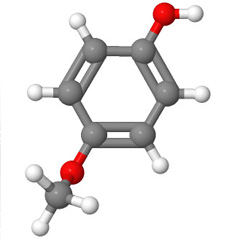







Mequinol molecule
Introduction
A derivative and alternative to hydroquinone is mequinol (hydroquinone monomethyl ether, 4-hydroxyanisole, para-hydroxymethoxybenzene). Similar to hydroquinone, mequinol is cytotoxic to melanocytes.
Mode of Action
It is enzymatically oxidized by tyrosinase to produce melanocytotoxic quinones. The formation of quinones results in pigment cell destruction and skin depigmentation. The mechanism by which mequinol causes depigmentation may also involve a competitive inhibition of tyrosinase; however, the exact pathway is unknown.
Although hydroquinone and mequinol are related, mequinol is thought to be less irritating to the skin than HQ.
Formulations
The drug is is typically formulated with 0.01% tretinoin, a retinoic acid and penetration enhancer. Mequinol is used in Europe in concentrations ranging from 2-20% and is approved in many countries for the treatment of solar lentigines.
Studies
Several large clinical studies have shown that mequinol effectively treats solar lentigines in all patients including ethnic populations. Reports indicate it is clinically effective in inhibiting melanogenesis when used as a combination of 2% 4HA cream and 0.01% retinoic acid. The authors reported minimal local skin irritation with this combination. Two percent 4HA alone did not produce significant hypopigmentation.
One other study compared mequinol 2%/tretinoin 0.01% to HQ 4% cream in 61 skin-of-color patients with mild-to-moderate facial post inflammatory hyperpigmentation. Patients applied each medication to contralateral sides of the face for 12 weeks. Topical mequinol/tretinoin was shown to be noninferior to 4% HQ as 81 and 85 percent of patients experienced clinical success on the mequinol-treated and the HQ-treated sides of the face, respectively.
>
>
>
>
>
>
>
>
>
>
>
>
>
>
>
>
>
>
>
>
>
>
>
>
>
>
>
>
>
>
>
>
>
>
>
>
>
>
>
>
>
>
>
>
>
>
>
>
>
>
>
TOP 20
Hydroquinone
Monobenzyl Ether of Hydroquinone
Azelaic Acid
Kojic Acid
Arbutin
Retinoids
Mequinol
Niacinamide
Soy
Vitamin C
Corticosteroids
Licorice
Hydroxystilbene
Aloesin
Glutathione
Glycolic Acid
N Acetyl Glucosamine
Gentisic Acid
Green Tea
Melatonin
SKIN WHITENING AGENTS A-Z
a-Hydroxyacids
Aloesin
Alpha Tocopherol and Alpha Tocopherol Ferulate
Arbutin
Azelaic Acid
Centaureidin and Methylophiopogonanone B
Gallic Acid and Derivatives
Gingko
Ginseng
Glutathione
Glycolic Acid
Green Tea
Hesperidin
Hydroquinone
Hydroxycinnamic Acid and Derivatives
Hydroxystilbene
Kojic Acid
Licorice
Linoleic Acid
Magnesium Ascorbyl Phosphate
Melatonin
Mequinol
Monobenzyl Ether of Hydroquinone
Mulberry
N Acetyl Glucosamine
N-Acetyl-4-S-Cysteminylphenol
Niacinamide
Retinoids
Salicylic Acid
Soy
Vitamin C

<< Previous: Retinoids
Next: Niacinamide >>